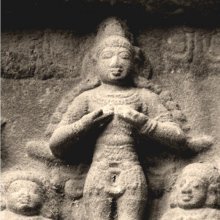Lolita: 10 definitions
Introduction:
Lolita means something in Buddhism, Pali, Hinduism, Sanskrit, Hindi. If you want to know the exact meaning, history, etymology or English translation of this term then check out the descriptions on this page. Add your comment or reference to a book if you want to contribute to this summary article.
Images (photo gallery)
In Hinduism
Natyashastra (theatrics and dramaturgy)
Source: Wisdom Library: Nāṭya-śāstra1) Lolita (लोलित).—One of the 108 karaṇas (minor dance movement) mentioned in the Nāṭyaśāstra chapter 4. It is also known by the name Lolitaka. The instructions for this lolita-karaṇa is as follows, “hands on the two sides to be Recita and Añcita, and the head Lolita and Vartīta.”. A karaṇa represents a minor dance movements and combines sthāna (standing position), cārī (foot and leg movement) and nṛttahasta (hands in dancing position).
2) Lolita also refers to a specific ‘movement of the head’ (śiras), according to the Nāṭyaśāstra chapter 8. It is also known by the name Parilolita. The head is one of the six major limbs (aṅga) used to perform certain gestures (āṅgika). These gestures form a part of the histrionic representation (abhinaya).
Source: archive.org: The mirror of gesture (abhinaya-darpana)One of the Twenty-four Heads. Lolita: the head unsteady, the eyes languid as if from excess of pride. Usage: sleepiness, obsession, intoxication, faintness.

Natyashastra (नाट्यशास्त्र, nāṭyaśāstra) refers to both the ancient Indian tradition (shastra) of performing arts, (natya—theatrics, drama, dance, music), as well as the name of a Sanskrit work dealing with these subjects. It also teaches the rules for composing Dramatic plays (nataka), construction and performance of Theater, and Poetic works (kavya).
In Buddhism
Tibetan Buddhism (Vajrayana or tantric Buddhism)
Source: OSU Press: Cakrasamvara SamadhiLolita (लोलित) refers to “motion”, according to the Cakrasaṃvara Samādhi [i.e., Cakrasamvara Meditation] ritual often performed in combination with the Cakrasaṃvara Samādhi, which refers to the primary pūjā and sādhanā practice of Newah Mahāyāna-Vajrayāna Buddhists in Nepal.—Accordingly, “I confess to making pleasurable intoxicants, depositing faults, completely, in front again, making the most excellent union, disciple Khaḍga Jinottama, Arhat, Buddha, capable, good, agreeable (and) awake, I bow completely, the triad, Jinaratna, etc., I am taking as much refuge, with my whole soul, bestowing awakened mind, the best path, practicing yoga in this manner. Vow being, knowledge being, observe one motion (eka-lolita)”.

Tibetan Buddhism includes schools such as Nyingma, Kadampa, Kagyu and Gelug. Their primary canon of literature is divided in two broad categories: The Kangyur, which consists of Buddha’s words, and the Tengyur, which includes commentaries from various sources. Esotericism and tantra techniques (vajrayāna) are collected indepently.
Languages of India and abroad
Pali-English dictionary
Source: Sutta: The Pali Text Society's Pali-English DictionaryLolita, (pp. of loleti) agitated, shaken Th. 2, 373 (=ālolita ThA. 252). (Page 589)

Pali is the language of the Tipiṭaka, which is the sacred canon of Theravāda Buddhism and contains much of the Buddha’s speech. Closeley related to Sanskrit, both languages are used interchangeably between religions.
Sanskrit dictionary
Source: DDSA: The practical Sanskrit-English dictionaryLolita (लोलित).—p. p. Shaken, tremulous.
Source: Cologne Digital Sanskrit Dictionaries: Shabda-Sagara Sanskrit-English DictionaryLolita (लोलित).—mfn.
(-taḥ-tā-taṃ) Shaken, tremulous, trembling. E. lul to agitate, aff. kta, and the vowel changed.
Source: Cologne Digital Sanskrit Dictionaries: Monier-Williams Sanskrit-English DictionaryLolita (लोलित):—[from lul] mfn. ([from] [Causal]) moved hither and thither, shaken, agitated, tremulous, [Śiśupāla-vadha]
Source: Cologne Digital Sanskrit Dictionaries: Yates Sanskrit-English DictionaryLolita (लोलित):—[(taḥ-tā-taṃ) a.] Shaken.
Sanskrit, also spelled संस्कृतम् (saṃskṛtam), is an ancient language of India commonly seen as the grandmother of the Indo-European language family (even English!). Closely allied with Prakrit and Pali, Sanskrit is more exhaustive in both grammar and terms and has the most extensive collection of literature in the world, greatly surpassing its sister-languages Greek and Latin.
Hindi dictionary
Source: DDSA: A practical Hindi-English dictionaryLolita (लोलित):—(a) oscillated; flickered.
...
Kannada-English dictionary
Source: Alar: Kannada-English corpusLōlita (ಲೋಲಿತ):—[adjective] not steady; not firm or stable; shaky; unsteady.
--- OR ---
Lōlita (ಲೋಲಿತ):—
1) [noun] a man with unsteady, capricious mind.
2) [noun] (dance.) the act of moving the head unsteadily, showing the feeling of sleepiness, sickness, intoxication or the condition of being possessed by an evil spirit, etc.
3) [noun] (dance.) one of the one hundred and eight coordinated movements of hands and feet.
--- OR ---
Lōḷita (ಲೋಳಿತ):—[adjective] = ಲೋಲಿತ [lolita]1.
--- OR ---
Lōḷita (ಲೋಳಿತ):—[noun] = ಲೋಲಿತ [lolita]2.
Kannada is a Dravidian language (as opposed to the Indo-European language family) mainly spoken in the southwestern region of India.
See also (Relevant definitions)
Starts with: Lolitaka, Lolitapushpaka.
Ends with: Alolita, Ekalolita, Hillolita, Kallolita, Parilolita, Ullolita, Vilolita.
Full-text: Alolita, Vilolitadrish, Parilolita, Parivamsha, Parivamshaka, Vilolita, Lolitaka, Virolita, Loleti, Kareṇu, Kallolita, Alolitamukam, Twenty-four Heads, Vilola, Shiras, Lola, Lud.
Relevant text
Search found 6 books and stories containing Lolita, Lōlita, Lōḷita; (plurals include: Lolitas, Lōlitas, Lōḷitas). You can also click to the full overview containing English textual excerpts. Below are direct links for the most relevant articles:
Gati in Theory and Practice (by Dr. Sujatha Mohan)
Gati in Kāma-avasthās < [Chapter 3 - Application of gati in Dṛśya-kāvyas]
Description of Gati in Abhinayadarpaṇa < [Chapter 2 - Concept and technique of Gati]
Gati in classical form of Mohiniāṭṭam < [Chapter 4 - Practice of Gati]
Vladimir Nabokov (1899-1977) < [April – June, 1979]
Post – Modern Literature < [October – December, 2004]
The Novels of Rabindranath Tagore < [July 1964]
Abhinaya-darpana (English) (by Ananda Coomaraswamy)
The Markandeya Purana (by Frederick Eden Pargiter)
Natyashastra (English) (by Bharata-muni)
Chapter IV - Description of the Class Dance (tāṇḍava)
Śrī Kṛṣṇa-karṇāmṛtam (by Śrīla Bilvamaṅgala Ṭhākura)
